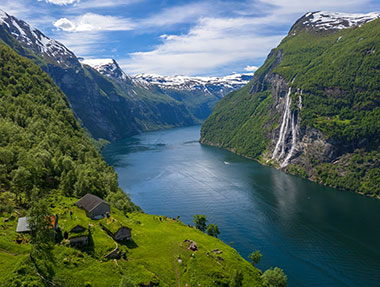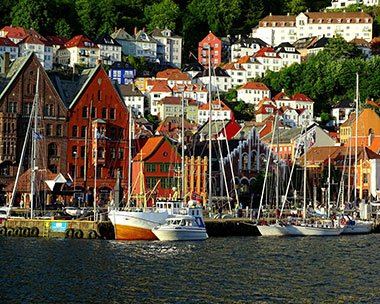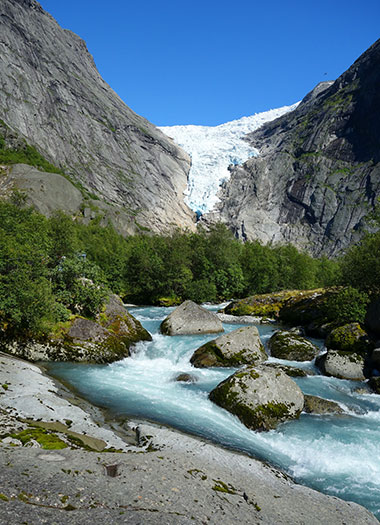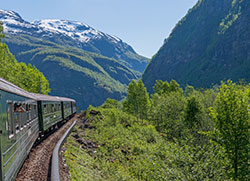Travel > Europe > Scandanavia > NorwayNorwayLand of Vikings and FjordsNorway, in one of the most beautiful countries on earth. Here, nature unfolds like a masterpiece, with majestic fjords carving their way through rugged landscapes, resplendent waterfalls cascading into crystalline lakes, and charming, colorful villages that seem to have sprung from the pages of a storybook. Yet, Norway is not just a canvas of stunning scenery; it's a living tapestry of history and culture. From the echoes of Viking legends to the enchanting Lapland reindeers that grace its pristine wilderness, Norway invites you to step into a world of warm hospitality and the genuine charm of fishing villages that dot its coastline. Witness the dancing Northern Lights and cruise through majestic fjords and experience the serenity of untouched nature. Norway offers the opportunity to experience Nordic culture and spectacular scenery for an unforgettable vacation. Oslo:
Scenic Flam Railway:
Bergen: The Gateway to the Fjords
Tromsø: Northern Lights and Arctic Adventures
Trondheim: A Medieval Gem
Stavanger: Coastal Beauty and Culinary Delights
Best Time to Visit:The best time to visit Norway depends on your interests and the experiences you're seeking. Norway experiences distinct seasons, each with its own unique charm and activities. Be aware that Norway's climate can vary significantly across the country, so your choice of when to visit may also depend on the specific region you plan to explore. Spring (March to May): Spring in Norway marks the end of the long, dark winter and the beginning of brighter days. As the snow melts, the landscape awakens with blossoming flowers and greenery. It's an excellent time for outdoor activities such as hiking and cycling, particularly in the southern parts of Norway. Cities like Oslo and Bergen come to life with outdoor events and cultural festivals. Don't forget to experience the traditional Easter celebrations, with skiing and other seasonal activities. Summer (June to August): Summer is the warmest and most popular season in Norway. The weather is typically at its best, making it ideal for exploring the stunning Norwegian fjords, swimming in crystal-clear lakes, and enjoying outdoor activities like hiking, kayaking, and camping. The entire country is vibrant with festivals and events, including the popular St. Hans or Midsummer celebrations in late June, which offer a unique cultural experience with bonfires and traditional festivities. Autumn (September to November): Autumn in Norway is a season of stunning natural beauty as the leaves change to vibrant shades of red, orange, and gold. It's an excellent time for hiking in the forests, visiting national parks, and experiencing the tranquility of the Norwegian countryside. The northern regions, such as Tromsø, are particularly attractive during this season, offering a chance to witness the Northern Lights. Food enthusiasts can indulge in seasonal Norwegian dishes and participate in local food festivals like the seafood festivals. Winter (December to February): Norwegian winters can be cold, but they are also enchanting, especially if you're a fan of winter sports and festivities. Popular winter activities include skiing, ice skating, and dog sledding. Northern Norway, including places like Tromsø, is a prime location to witness the magical Northern Lights during the extended nights. The Christmas season is a special time to visit cities like Oslo, Bergen, and Trondheim, as they are adorned with holiday decorations and festive markets. Warm up in cozy cafés or saunas, and don't forget to try traditional Norwegian holiday dishes like ribbe (pork belly) and gingerbread cookies. Travel Planning Tips:Plan Ahead: Before embarking on your Norwegian adventure, take the time to research the cities, regions, and attractions that interest you. Create a list of must-see places and plan your itinerary accordingly. Norway offers a diverse range of experiences, from historic cities to pristine natural landscapes, so tailor your trip to your preferences. Cash and Currency: Norway uses the Norwegian Krone (NOK) as its currency. Inform your bank about your travel plans to prevent any issues with your credit or debit cards. While cards are widely accepted, it's a good idea to carry some cash, especially for small purchases and in rural areas where card acceptance may be limited. Norway has a cashless culture, so having a credit or debit card is essential. Tipping in Norway is generally not as common as in some other countries, but it's appreciated for exceptional service, usually rounding up the bill or leaving a small tip. Travel Insurance: Ensure that you have comprehensive travel insurance that covers medical expenses, trip cancellation, and emergencies when visiting Norway. Familiarize yourself with the policy details and know how to access medical assistance if needed. Check Visa Requirements: Depending on your nationality, you may need a visa to enter Norway. Check visa requirements well in advance and apply if necessary. Ensure that your passport remains valid for at least six months beyond your planned departure date. Pack Accordingly: Norway experiences a wide range of temperatures throughout the year. Pack clothing suitable for the season of your visit. Layers are useful for adapting to changing weather. Comfortable walking shoes are essential for exploring cities and attractions. Also, bring a universal power adapter for charging your electronic devices, as Norway uses Type C and Type F electrical outlets. Local Etiquette: When in Norway, respect local customs and etiquette. Norwegians are known for their politeness and punctuality. Be sure to queue in an orderly fashion, and always say "please" (vær så snill) and "thank you" (takk) in your interactions with locals. Tipping is not as common as in some other countries, but it's appreciated for good service, usually rounding up the bill. Drinking tap water is safe and environmentally friendly, so bring a reusable water bottle to stay hydrated. Accommodations:Hotels: Norway offers a wide range of hotels, from luxury to budget-friendly options. Many hotels are equipped with amenities for all types of travelers. You can inquire about any senior discounts or special rates when booking your stay. Guesthouses and Bed & Breakfasts: Guesthouses and B&Bs in Norway provide a cozy and personalized experience. These accommodations are often run by local hosts who offer warm hospitality. Staying in a guesthouse or B&B allows retirees to interact with locals and immerse themselves in authentic Norwegian culture. Spa and Wellness Resorts: For those seeking relaxation and wellness, Norway has numerous spa and wellness resorts. These establishments offer rejuvenating treatments, saunas, and relaxation facilities. Consider staying at one of these retreats in picturesque areas like the Norwegian Fjords, Telemark, or the Arctic regions, where you can unwind in natural beauty. Transportation:Norway offers a diverse range of transportation options to cater to different travel preferences and needs, whether you prefer the convenience of public transportation, the flexibility of driving, or a mix of both to explore this beautiful country. Here's some helpful information for getting around in Norway: Oslo Pass: Oslo, the capital of Norway, offers the "Oslo Pass," which provides access to the city's comprehensive public transportation system. This pass also grants entry to many museums and attractions. It's a convenient way to explore Oslo, and you can purchase it at tourist information centers, hotels, and online. Domestic Flights: While Norway is relatively compact, domestic flights are available for longer journeys or travel to remote regions like Northern Norway or the Svalbard archipelago. Airlines like Scandinavian Airlines (SAS) and regional carriers operate these routes. Flying can save time for more distant destinations, but it may not always be the most budget-friendly option for shorter trips. Trains: Norway boasts an extensive and efficient train network, operated by Vy. Trains connect major cities and regions, providing a convenient and scenic way to explore the country. Consider purchasing rail passes for extended travel, and booking tickets in advance is advisable, especially for peak times and long-distance routes. Buses: Buses are a popular mode of transportation for regional and local travel in Norway. Companies like Nor-Way Bussekspress and Norwegian Air Shuttle operate bus services that connect cities and rural areas. Similar to trains, booking tickets in advance is recommended, and bus services are cost-effective for reaching areas that may not have direct train connections. Rental Cars: Various international and local car rental companies operate in Norway, including well-known brands like Hertz, Avis, Europcar, Enterprise, and Budget. You can find rental offices at major airports, cities, and popular tourist destinations. In Norway, driving is on the right side of the road, and cars have the steering wheel on the left side. The road network is well-maintained, including highways (E-roads) and national routes (R-roads). Be prepared for varying road conditions, including narrow and winding roads, especially in rural areas. Be aware of wildlife on the road, especially moose and reindeer. Roundabouts are common traffic features, so familiarize yourself with roundabout rules and understand the proper lanes to use when approaching and exiting them. Taxis: Taxis in Norway are generally safe and reliable. Look for licensed taxis with a taxi sign on the roof and a taxi meter inside. Fares are typically based on distance traveled, with additional charges for luggage or late-night rides. Taxis in Norway typically accept both cash and credit cards. Tipping is customary and often involves rounding up the fare or offering a small additional amount. Public Transportation: Norwegian cities have efficient public transportation systems, including buses, trams, and metros. Oslo, for instance, offers the Oslo Pass, while other cities have their own networks. Tickets can usually be purchased from ticket machines or via mobile apps. Consider day passes or multi-day passes for unlimited travel within specific cities or regions. Safety Tips:
|
 Geirangerfjord, Norway Geirangerfjord, NorwayPhoto by admiratio / Unsplash  Bergen, Norway Bergen, NorwayPhoto by Miguel Ángel Sanz / Unsplash  Briksdal Glacier, Norway Briksdal Glacier, NorwayPhoto by Uniq Trek / Unsplash | |||||||||||||||||||||||||
